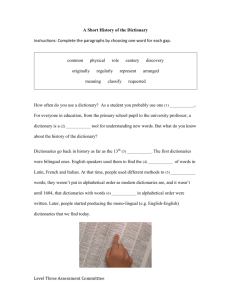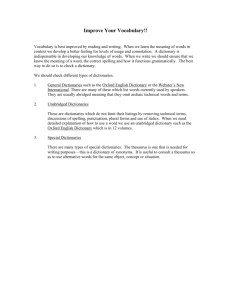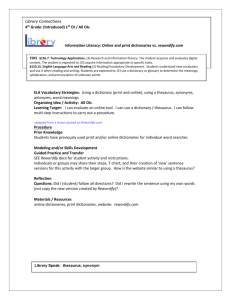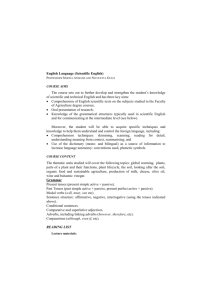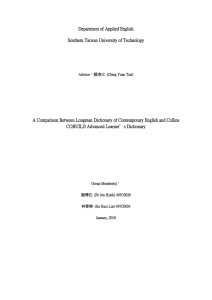JUST FOR KICKS: THE LANGUAGE LOVERS
advertisement
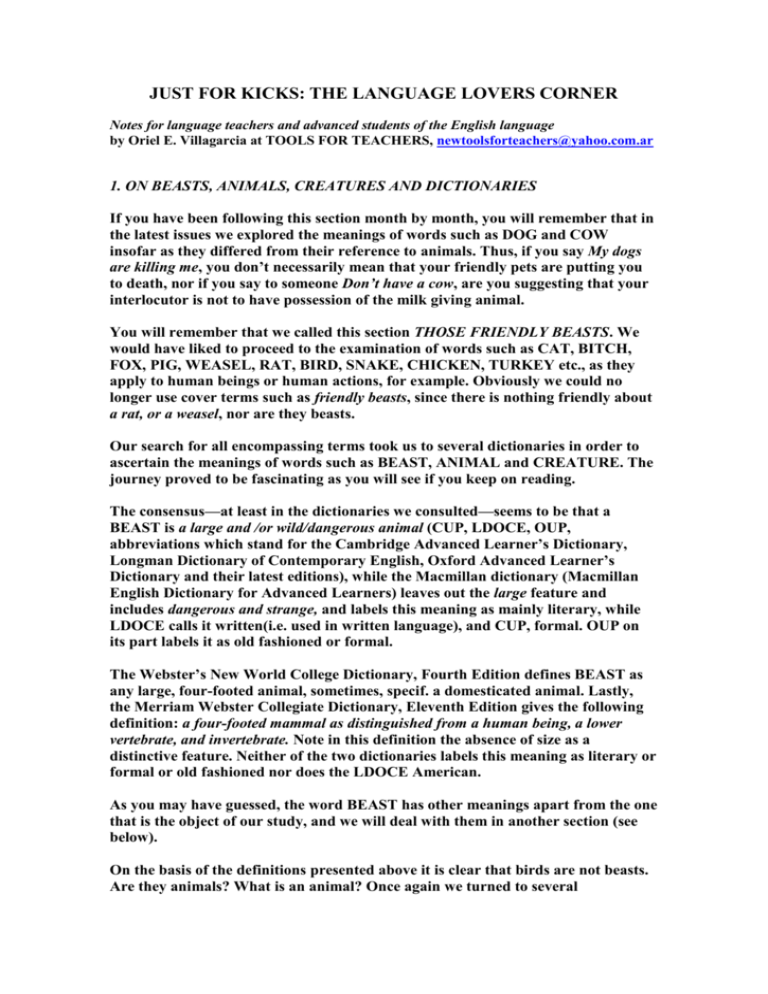
JUST FOR KICKS: THE LANGUAGE LOVERS CORNER Notes for language teachers and advanced students of the English language by Oriel E. Villagarcia at TOOLS FOR TEACHERS, newtoolsforteachers@yahoo.com.ar 1. ON BEASTS, ANIMALS, CREATURES AND DICTIONARIES If you have been following this section month by month, you will remember that in the latest issues we explored the meanings of words such as DOG and COW insofar as they differed from their reference to animals. Thus, if you say My dogs are killing me, you don’t necessarily mean that your friendly pets are putting you to death, nor if you say to someone Don’t have a cow, are you suggesting that your interlocutor is not to have possession of the milk giving animal. You will remember that we called this section THOSE FRIENDLY BEASTS. We would have liked to proceed to the examination of words such as CAT, BITCH, FOX, PIG, WEASEL, RAT, BIRD, SNAKE, CHICKEN, TURKEY etc., as they apply to human beings or human actions, for example. Obviously we could no longer use cover terms such as friendly beasts, since there is nothing friendly about a rat, or a weasel, nor are they beasts. Our search for all encompassing terms took us to several dictionaries in order to ascertain the meanings of words such as BEAST, ANIMAL and CREATURE. The journey proved to be fascinating as you will see if you keep on reading. The consensus—at least in the dictionaries we consulted—seems to be that a BEAST is a large and /or wild/dangerous animal (CUP, LDOCE, OUP, abbreviations which stand for the Cambridge Advanced Learner’s Dictionary, Longman Dictionary of Contemporary English, Oxford Advanced Learner’s Dictionary and their latest editions), while the Macmillan dictionary (Macmillan English Dictionary for Advanced Learners) leaves out the large feature and includes dangerous and strange, and labels this meaning as mainly literary, while LDOCE calls it written(i.e. used in written language), and CUP, formal. OUP on its part labels it as old fashioned or formal. The Webster’s New World College Dictionary, Fourth Edition defines BEAST as any large, four-footed animal, sometimes, specif. a domesticated animal. Lastly, the Merriam Webster Collegiate Dictionary, Eleventh Edition gives the following definition: a four-footed mammal as distinguished from a human being, a lower vertebrate, and invertebrate. Note in this definition the absence of size as a distinctive feature. Neither of the two dictionaries labels this meaning as literary or formal or old fashioned nor does the LDOCE American. As you may have guessed, the word BEAST has other meanings apart from the one that is the object of our study, and we will deal with them in another section (see below). On the basis of the definitions presented above it is clear that birds are not beasts. Are they animals? What is an animal? Once again we turned to several dictionaries. The first definition for ANIMAL in LDOCE reads: a living creature such as a dog or cat, that is not an insect, plant, bird, fish or person. Its second definition states that it is any living creature that is not a plant or person. This is of course in direct contrast with the previous definition as it implies that birds, insects and fish are animals. Macmillan, on the other hand, first of all offers a definition from the field of biology classifying animals into vertebrates and invertebrates. Next, it echoes the first definition offered by LDOCE, and then goes on to offer an even broader definition: any living creature including humans, and gives as an illustrative example of this meaning the sentence Man is the only animal that uses language. CUP goes along with LDOCE and Macmillan and gives this illustrative example: Humans, insects, reptiles, birds and mammals are all animals. OUP gives definitions along the lines of the dictionaries already mentioned, whereas four footedness and the exclusion of humans are the main features for the definition of animals in the Webster’s New World Dictionary. Merriam Webster’s highlights the feature that tell animals apart from plants in one definition, and sets humans apart from animals in another definition. How is a bird to be defined? If a bird is not an animal how is it to be defined? Or, as we saw above, perhaps a bird is an animal. A bird, says LDOCE is a CREATURE with wings and feathers that can usually fly. CUP offers a similar definition, and so does OUP highlighting the fact that birds have two legs. Macmillan, however, calls a bird an animal covered with feathers with two wings for flying and a hard pointed moth called a beak or a bill. Birds build nests in which female birds lay eggs. Is a chicken a bird? Yes. All four dictionaries agree in this respect. Merriam Webster’s introduces the word FOWL in defining a chicken: the common domestic fowl (Gallus Gallus) esp. when young. The word BIRD covers small winged biped creatures such as pigeons and sparrows and large ones as ostriches and eagles. So far, so good. You will remember that some dictionaries excluded bird, fish and insects from the animal category. However, if you look up fish in CUP you will find the definition an animal which lives in water, and both LDOCE and Macmillan go along with that classification, whereas OUP calls a fish a CREATURE. Webster’s New World and Merriam Webster’s also include the word animal in their definition of fish. When it comes to the word INSECT, LDOCE and OUP call it a creature, unlike Macmillan and CUP which call it an animal. On the other hand, all six dictionaries referred to so far consistently classify BEES and SPIDERS as INSECTS rather than as animals. What are we to make of the apparent contradictions in the definitions offered by different dictionaries? Are there any serious errors? It is our contention that there are none, if you remember that practically all of the dictionaries offer first restricted definitions for the word ANIMAL, and a broader one immediately afterwards. The same holds for a dictionary which deserves to be listed and referred to, namely the COLLINS COBUILD ADVANCED LEARNER’S DICTIONARY, FOURTH EDITION, a masterpiece in lexicography which when it was first published in 1987 represented a step forward in making definitions user friendly for the learner of English as a foreign/second language. Roughly speaking, both Webster’s New World and Merriam Webster’s are in agreement with the five dictionaries referred to above. It is important to remember, nevertheless, that both Webster dictionaries are aimed at those whose mother tongue is English, and that fact makes a world of difference. Unlike the dictionaries meant for native speakers of English, the five dictionaries mentioned in this article make use of a highly restricted defining vocabulary, ranging from only 2000 word in LDOCE and CUP, about 2300 in Macmillan, 2500 in COBUILD to 3000 in OUP. Lexicographers for those dictionaries have striven for clear, transparent definitions which in most cases can be understood by students at an intermediate level (half way through FCE preparation). For illustrative purposes emphasizing the contrast between dictionaries for native and non native speakers of English, we reproduce the definitions of ANIMAL given by Webster’s New World, and Merriam Webster’s respectively: A. 1. any of a kingdom (Animalia) of eukaryotes generally characterized by a multicellular body, the ability to move quickly and obtain food, specialized sense organs, and sexual reproduction. B. 1. any of a kingdom (Animalia) of living things including many-celled organisms and often many of the single-celled ones (as protozoans) that typically differ from plants in having cells without cellular walls, in lacking chlorophyll and the capacity for photosynthesis, in requiring more complex food materials (as proteins), in being organized to a greater degree of complexity, and in having the capacity for spontaneous movement and rapid motor responses to stimulation. Different strokes for different folks. Still, one point remains to be elaborated upon. How is it possible that a word may have different, even contradictory meanings? The answer to this, we believe, lies in the nature of human beings, and language reveals the complexity of man, its evolving nature, its contradictions, apparent or real, and its innate creativity. Language seems to have a life of its own. Words come into being, change their meaning in the course of years, die out and sometimes are reborn. As a God given gift, language would seem to serve every human purpose. We make love, make war, we pray, we curse, and we create infinite realities through language. It is the lexicographer job to record , define, explain and elucidate the meaning of words through words, a mammoth job if you stop to think about it, particularly if you consider the fact that very possibly not two human beings use the same words in exactly the same way, or assign the same meanings to them. Yet, it is a miracle that we do communicate because despite our different views of the world reflected in language, there seems to be a common core that allows us to interact and against all odds keep the human species alive. To end on a lighter note, and in keeping with the spirit of JUST FOR KICKS, we invite you now to proceed to the next section, where we do what have been doing in previous issues, i.e. exploring what might perhaps be the unfamiliar meanings of familiar words. As it was to be expected, we will be dealing with additional meanings of ANIMAL, BEAST and CREATURE. 2. FURTHER MEANINGS OF FAMILIAR WORDS ANIMAL This word can also indicate cruelty, violence: That man is an animal. a particular characteristic that singles someone out: a political/social party animal: Alfonsin has always been a party animal. something that is different from what you have mentioned: Text messaging is a very different animal from other kinds of writing. (based on LDOCE). a passionate sexual partner BEAST Other meanings: mainly in journalism: a cruel or immoral person, especially one who behaves in a violent or sexual way. humorous; used for describing something with a particular quality: The music business is an unpredictable beast (Macmillan,verbatim). an unattractive woman (mainly American usage) an attractive woman (mainly American usage) CREATURE Notice the following: a beautiful/adorable/pathetic/pitiful/nocturnal/bizarre creature As can be seen CREATURE can be preceded by positive or negative adjectives. a creature of habit: someone who likes to do the same thing at the same time every day (Macmillan) a creature of the government, police, mafia, etc. is someone controlled by them. the creature: whisky or another intoxicating liquor (Webster’s New World) 3. TEST YOUR ENGLISH You will have noticed that compounding in written English is represented in three different ways: a) teapot (a single word) b) pop-eyed (two words joined by a hyphen) c) tear gas (two words) In the following activity, match the numbers with the letters, and assign the matching words to any of the three categories indicated above. Have fun! 1. trigger 2. riot 3. rip 4. pumper 5. knock 6. cross 7. punch 8. tracing 9. drag a. act b. paper c. line d. dresser e. happy f. roaring g. queen h. kneed i. nickel Answer to this section are given right before the end of this issue of JUST FOR KICKS 4. ACTIVATING YOUR VERBAL INTELLIGENCE Examine the following sentence and explain what it means: I think that the Fish and and and Chips are too apart on this sign. The first three participants who submit the correct answers will receive a gift. Email newtoolsforteachers@yahoo.com.ar with your full name and phone number. Enjoy! 5. ANSWER TO THE PREVIOUS ISSUE PROBLEM You will remember that in the previous issue we said that the name of a well known bookstore in Ciudad de Buenos could be translated into English by the sentence THAT ONE SEES THAT ONE. Another clue to solve this puzzle was that this bookstore sells books in English, Italian, Portuguese and Spanish as a foreign language. The correct answer is, of course, SBS, since THAT ONE SEES THAT ONE translates into ESE VE ESE. We are dealing with homophones, here! We are glad to announce the name of the winner, VALERIA LARRALDE, from Tigre, Buenos Aires. SBS is sending her a book as a present. ANSWERS TO TEST YOUR ENGLISH 1. 2. 3. 4. 5. 6. e a f i h d 7. c 8. b 9. g Your next step is to look up these combinations, find out which category they belong to, i.e. whether (a), (b) or (c), and check their meaning if necessary. Enjoy! Oriel E. Villagarcia holds and M.A. in Linguistics for English Language Teaching from the University of Lancaster, and was on the Advisory Panel for the Macmillan English Dictionary, First Edition. He is available for workshops on language and methods throughout Argentina and abroad. Write to him at newtoolsforteachers@yahoo.com.ar


